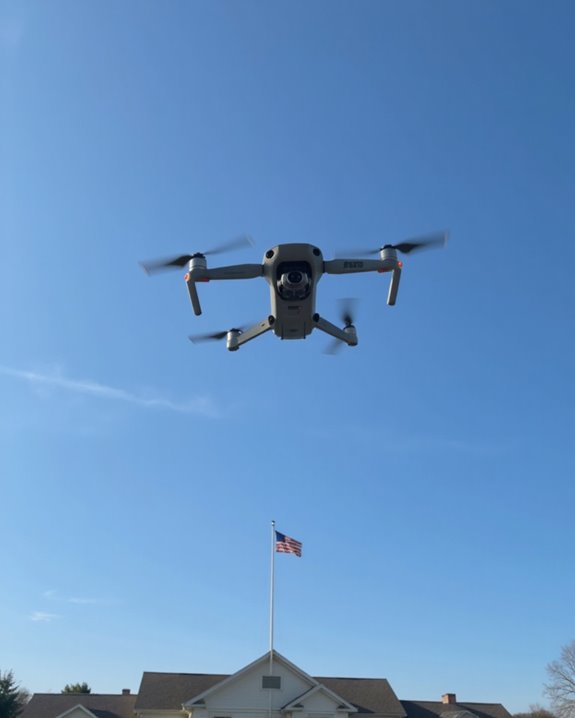To become a certified drone pilot, individuals must be at least 16 years old and obtain an FAA Remote Pilot Certificate. The process involves getting an FAA Tracking Number, studying regulations and airspace knowledge, passing the $175 aeronautical knowledge test at one of 800+ testing centers, and submitting Form 8710-13. Don’t forget to register your drone if it weighs over 0.55 pounds! Certificates require renewal every 24 months through a recurrent test. The journey to commercial drone operations opens doors to exciting career opportunities in various industries!
Key Takeaways
- Obtain an FAA Tracking Number (FTN) by registering on the IACRA website as your first step.
- Pass the FAA Aeronautical Knowledge Test covering regulations, airspace, weather, and safety procedures.
- Submit FAA Form 8710-13 electronically through IACRA after passing the test.
- Meet eligibility requirements: minimum age 16, English proficiency, and proper identification.
- Complete recurrent training every 24 months to maintain certification and stay current with regulations.
Understanding Part 107 Drone Certification Requirements
Why is Part 107 certification the golden ticket to professional drone operations? This essential credential, issued by the Federal Aviation Administration, transforms recreational flyers into legitimate commercial drone pilots! The certification process requires passing a thorough knowledge test covering airspace classifications, weather patterns, and safety protocols.
Unlike some International Comparisons where drone regulations vary wildly, the US system provides a clear pathway to legal commercial operations. Pilots must navigate not only FAA requirements but also State Regulations that might impose additional restrictions in certain areas.
The Part 107 license opens doors to lucrative opportunities in aerial photography, surveying, and inspection services. Remember, your drone business can’t legally take flight without this certification in hand, so studying for that knowledge test is time well invested! Maintaining your Part 107 certification with recurrent testing ensures you stay compliant and updated with evolving regulations.
Age and Eligibility Requirements for Remote Pilots
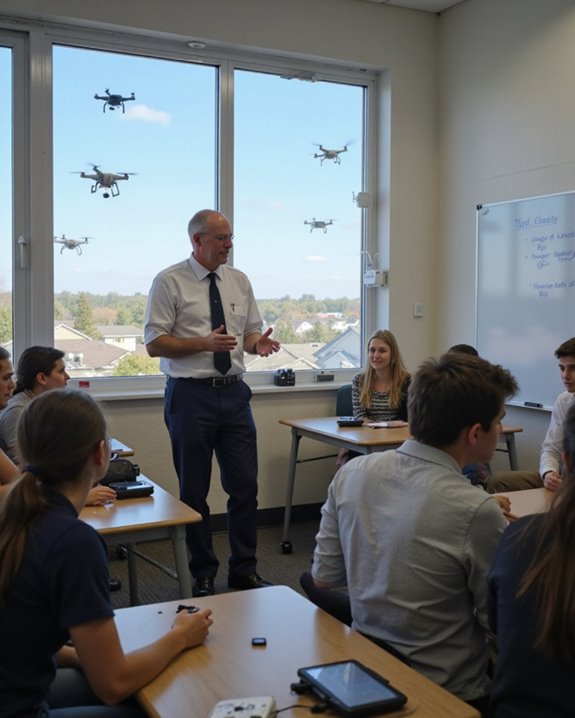
The journey to becoming a certified drone pilot begins with meeting several key eligibility requirements, with age being the first critical checkpoint. The FAA has established clear Youth Eligibility standards, requiring all remote pilots to be at least 16 years old to obtain certification—no exceptions! While younger enthusiasts aged 13 and up can register drones, they’ll need to wait for their sweet sixteen to fly commercially.
Beyond age considerations, pilots must demonstrate English language proficiency to understand critical safety communications. Health Standards are equally important, though no formal medical certificate is required. Remote pilots must self-assess their physical and mental fitness before each flight, ensuring they’re not impaired by medication, fatigue, or that second glass of celebratory champagne! Registration compliance and periodic recurrent training round out the eligibility package for aspiring drone professionals. Many sub-250g drones, such as the DJI Mini 3, benefit from relaxed FAA registration requirements for recreational use, which can simplify the initial learning phase for new pilots.
Preparing for the FAA Aeronautical Knowledge Test

Preparing for your FAA Aeronautical Knowledge Test represents the pivotal bridge between drone enthusiasm and professional certification. This in-person exam, administered at approved FAA testing centers, covers essential topics like airspace classification, weather factors, and UAS regulations that every commercial drone pilot must master.
Smart exam strategies can greatly reduce test anxiety! Schedule your test after thoroughly reviewing study materials designed specifically for Part 107 preparation, including practice questions that mirror the multiple-choice format you’ll encounter. Remember, you’ll need a government-issued photo ID and the test fee when you arrive. The good news? With proper preparation, those airspace diagrams that once looked like abstract art will suddenly make perfect sense! Upon passing with the minimum required score, you’ll be ready to complete your Remote Pilot Certificate application. Additionally, understanding the importance of FAA compliant remote ID modules can help you stay updated with current drone operation regulations.
Obtaining Your FAA Tracking Number (FTN)
Securing your FAA Tracking Number represents the essential first step in your journey toward drone certification success. The FTN serves as your unique identifier throughout the certification process, connecting all your test results and applications in one seamless system. To obtain yours, visit the IACRA website, select the “applicant” role, and follow the straightforward registration steps.
While IACRA Alternatives don’t exist for FTN creation (it’s the official system!), the process is typically smooth sailing. Should you encounter hiccups, FTN Troubleshooting resources are readily available through the FAA’s support channels. Remember to record your number somewhere safe – you’ll need it repeatedly! The best part? Your FTN never expires, providing lifetime access to your certification records. One small number, one giant leap toward your drone piloting dreams!
Scheduling Your Exam at an Approved Testing Center

Once your FTN is secured, finding the perfect testing center to take your Part 107 exam becomes your next crucial mission! PSI, the FAA’s official testing company, manages all Exam Logistics through their convenient scheduling platform. With over 800 testing centers nationwide, your Center Selection options are impressively abundant!
The exam costs $175, so you’ll want to make the most of your investment. Simply create a PSI account using your FAA Tracking Number, then use their searchable map or zip code tools to locate a center near you. Many states, including New York and Colorado, offer multiple testing locations for your convenience. The multiple-choice format allows for flexible scheduling options—just make sure you’re thoroughly prepared before booking your spot!
Essential Study Topics for Drone Certification Success
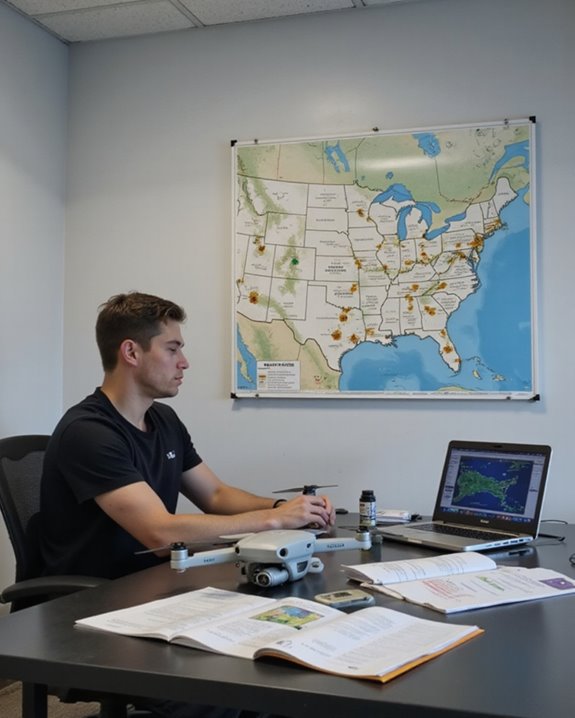
With the logistics of exam scheduling behind you, mastering the right content becomes your path to success on test day! The FAA exam covers five critical areas that every aspiring drone pilot must understand thoroughly.
Airspace management tops the list, requiring you to distinguish between Class G, Class E, and restricted zones. Weather Planning isn’t just about checking for rain—you’ll need to interpret Airmets, Sigmets, and recognize dangerous conditions that could impact your drone’s stability. Safety Protocols, including emergency procedures and risk assessment, guarantee you’re prepared when things don’t go as planned (and they sometimes won’t!). Don’t forget regulatory knowledge covering Part 107 requirements and waiver processes. Finally, understanding aircraft performance and maintenance might save your expensive equipment from an unfortunate meeting with gravity!
Navigating the Application Process After Passing Your Exam
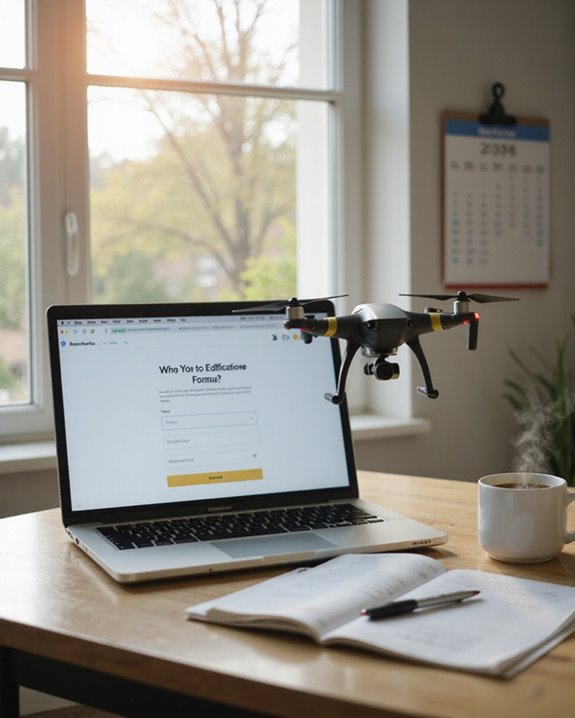
Congratulations, you’ve passed the knowledge test—but what happens next? Your journey to becoming a certified drone pilot now moves to the Form Submission phase through IACRA, the FAA’s official electronic application platform.
First, make sure your IACRA profile exactly matches your government ID—even small discrepancies can delay your certification! Submit your completed FAA Form 8710-13 electronically, along with required documentation and proof of test passage. Part 61 pilots, don’t forget to include your flight review evidence!
Processing Times typically range from a few days to several weeks, depending on FAA workload and application completeness. During this period, the FAA conducts identity verification and security checks. Once approved, you’ll receive an electronic certificate—your golden ticket to commercial drone operations!
Equipment Standards and Registration Requirements
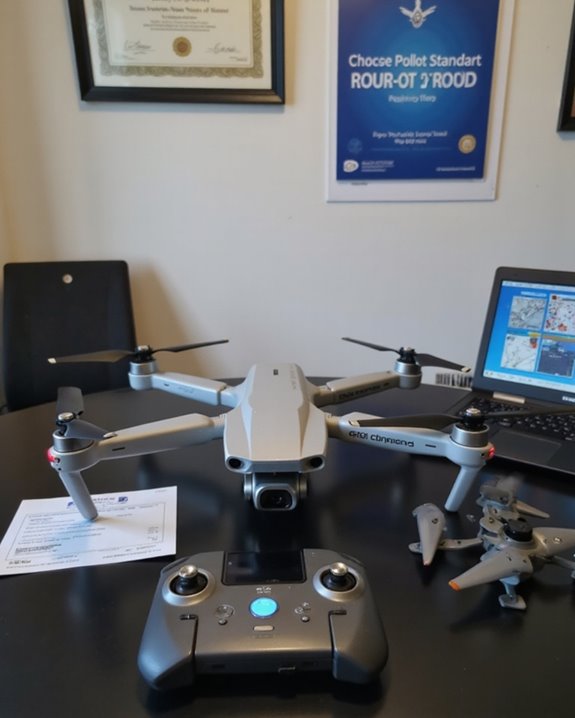
The equipment a drone pilot carries into the field is just as essential as the knowledge they bring to the cockpit! All drones weighing more than 0.55 pounds must be registered with the FAA, receiving a unique identifier that must be visibly labeled on the aircraft. Regular Drone Maintenance guarantees your equipment remains in airworthy condition, a critical safety requirement.
Small UAS typically weigh under 55 pounds and must include safety features like GPS and obstacle avoidance systems. Smart pilots also equip their drones with propeller guards and verify weather resistance capabilities before flight! Remember, Registration Updates are necessary whenever you change address information or transfer ownership.
Your drone must also meet operational requirements, including staying below 400 feet altitude and remaining within your visual line of sight—no exceptions for even the most exciting shots!
Maintaining Your Remote Pilot Certification
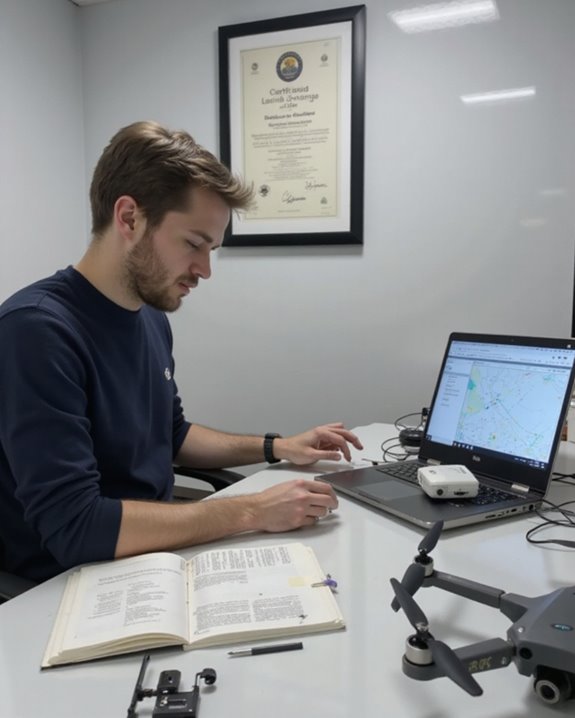
Maintaining your drone pilot certification requires diligent attention to timelines and training requirements! The FAA mandates that Remote Pilot Certificate holders complete recurrent training every 24 calendar months to stay current. Since March 2021, this process has become substantially easier, with online refresher courses replacing in-person tests.
Training Frequency is critical to remember—mark those calendars for every two years from your initial certification month! The online courses cover essential topics like regulations, weather factors, and operational safety. Many of these resources are even free through the FAA Safety website, making compliance both accessible and affordable.
Record Keeping is equally important for drone pilots. Always maintain documentation of your completed training, as these records must be available during operations and potential FAA audits. No pilot wants to be grounded over paperwork!
Commercial Opportunities for Certified Drone Pilots

With your certified drone pilot status secured and maintenance protocols in place, a world of profitable opportunities awaits! Certified pilots consistently earn higher salaries than their non-certified counterparts, with annual earnings ranging from $60,000 to over $130,000 depending on industry and experience.
Job prospects are particularly robust in aerospace, construction, and environmental services sectors. Film production and surveying also offer lucrative paths for skilled operators! Freelance gigs provide higher hourly rates and project flexibility, while full-time positions deliver stability and benefits. Geographic location matters too—Northeast and West regions typically offer more competitive compensation.
The industry’s outlook remains bright, with technological advancements continually expanding commercial applications. Whether you’re mapping construction sites or capturing cinematic footage, your certification is the key that opens these diverse, well-paying opportunities!
Frequently Asked Questions
Can I Fly My Drone Internationally With a US Certification?
US certification alone is insufficient for international drone operations. International regulations require compliance with local laws in each country. The FAA Part 107 certification’s recognition is limited to United States airspace only.
How Does Insurance Work for Commercial Drone Operations?
In the most critical aspect of commercial drone operations, insurance offers protection through liability coverage for third-party claims. Premium rates vary based on operation risk, certification status, and coverage levels from $1 million to $5 million.
What Disabilities Might Prevent Someone From Obtaining Drone Certification?
Severe sensory impairments, particularly vision conditions, may prevent drone certification, as would medical disqualifications like epilepsy, uncontrolled psychiatric conditions, or neurological disorders causing sudden incapacitation. Part 107 requires self-assessment of operational fitness.
Are Waivers Available for Flying in Restricted Airspace?
Despite common misconceptions, waivers are indeed available for restricted airspace operations. Waiver eligibility exists for controlled airspace when LAANC is unavailable, but operators must demonstrate safety mitigations and submit applications through the FAA DroneZone portal.
How Do Weather Conditions Affect Drone Certification Test Scheduling?
Weather impacts on drone certification test scheduling are minimal. The exam occurs indoors, so scheduling factors aren’t affected by external conditions. Knowledge of weather remains essential for the test content regardless of timing.





